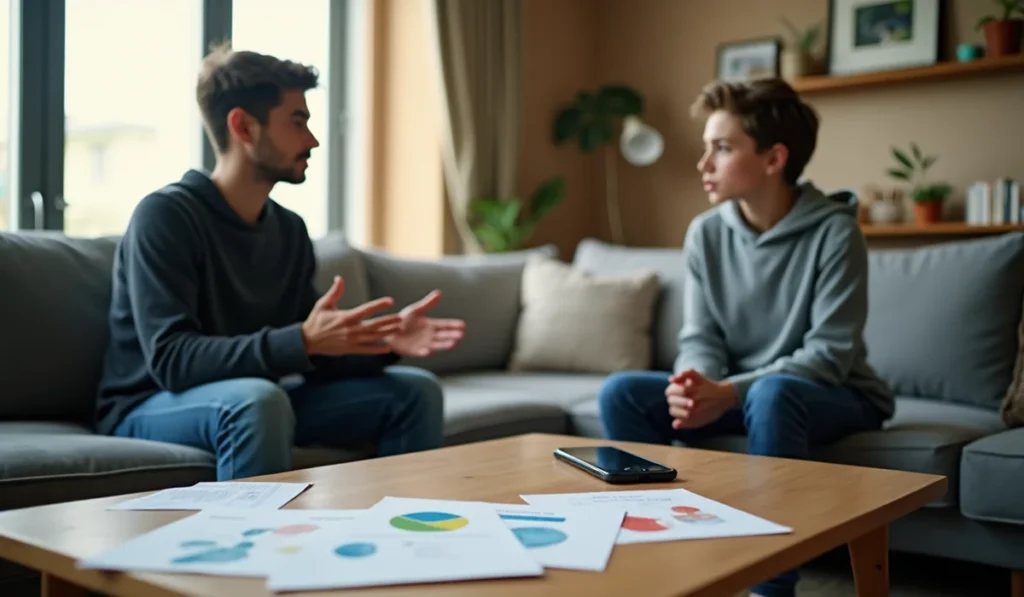Teen cannabis use has reached worrying levels. Recent data shows 40% of teenagers under 18 have tried cannabis. The situation becomes more concerning when you consider today’s cannabis contains up to 28% THC. This represents a stark contrast to cannabis from the 1990s, which contained less than 2% THC.
Young users face serious risks. Research shows teens are twice as likely as adults to develop cannabis use disorders. Regular use puts up to 33% of young people at risk of substance use problems. Traditional scare tactics in drug education just don’t work. Parents and educators need practical strategies that make a real difference. This piece explores proven approaches to help you talk with teens about cannabis. You’ll learn practical harm reduction techniques that can create lasting impact.
Understanding Teen Cannabis Use Today
Recent surveys show cannabis remains the most commonly used illicit substance among American teenagers. About 30.7% of high school seniors reported using it last year. The numbers have dropped from previous years, yet daily cannabis use still worries experts with 6.3% of 12th graders using it daily. Cannabis vaping has become a major trend, and 21% of high school seniors say they vaped cannabis in the past year.
Current trends in adolescent cannabis use
Teen cannabis use patterns have altered the map in the last several years. The data shows current marijuana use among adolescents dropped from 23.1% in 2011 to 15.8% in 2021. First-time use before age 13 substantially decreased from 8.1% to 4.9% during this period. In spite of that, usage patterns reveal troubling variations in demographics. Students in 12th grade (22.4%) show higher rates than younger students.
The gender dynamics of cannabis use have changed dramatically. Girls reported higher rates of current marijuana use (17.8%) than boys (13.6%) by 2021. This completely reversed the 2011 pattern where boys led at 25.9% compared to girls at 20.1%. The data also shows racial differences. Black adolescents report higher current marijuana use (20.5%) compared to their white (14.8%), Hispanic (16.7%), and Asian (5.1%) peers.
Cannabis potency has risen dramatically. Modern cannabis contains THC concentrations of 20-25%, unlike the 1-2% common decades ago. Some cannabis concentrates now contain up to 76% THC. These unprecedented levels present new risks to developing brains.
Why traditional scare tactics don’t work
Research consistently shows that drug prevention efforts based on fear-based messaging fail to reduce substance use. Multiple studies prove that strategies using scare tactics, moralistic appeals, and information-only approaches about dangers don’t work.
Fear-based prevention fails for several reasons:
- Teens have excellent “BS detectors” and reject exaggerated claims
- Teens ignore warnings when they see peers using cannabis without immediate negative effects
- Fear appeals can spark curiosity about drug use instead of preventing it
- Strong emotional fear responses can weaken self-control over drinking behaviors
Prevention experts have moved away from dramatic tactics like testimonials from former addicts, gruesome imagery, or one-time assemblies. In stark comparison to this, successful approaches focus on fixing misconceptions about teen cannabis use rates and promoting autonomy through messages like “be under your own influence”.
The science behind teen brain development and cannabis
The human brain develops until about age 25. The teen years mark a vital period for brain maturation. Teen brains undergo essential processes including myelination (insulating neural connections) and synaptic pruning (eliminating unnecessary connections). The prefrontal cortex plays a key role in decision-making, impulse control, and judgment. This area develops actively during these years.
Cannabis contains chemicals that bind to cannabinoid receptors throughout the brain, especially in areas vital for memory, learning, and executive function. Research shows adolescent exposure to cannabis disrupts these sensitive developmental systems. THC activates the brain’s stress mechanisms more intensely than before, which might lead to increased anxiety, depression, and social avoidance.
The potential risks can be serious. Teens who start using cannabis before age 16 show poorer performance on cognitive tasks that test memory, attention, and judgment. Brain scans reveal changes in white matter – essential for communication between brain regions – in early-onset users. Each year a teenager waits to use cannabis reduces their risk of developing cannabis use disorder by about 10%.
Users who begin during adolescence face higher risks of substance dependence. Regular teen cannabis users showed 37 times higher odds of tobacco dependence, 3 times higher odds of harmful alcohol use, and 26 times higher odds of other illicit drug use in adulthood compared to non-users.
The current generation shows different substance priorities. Gen Z drinks less alcohol than previous generations but seems more attracted to cannabis and psychedelics as “the cool thing to be doing”. Modern prevention and treatment approaches must understand that teens use substances for specific reasons – usually social connection or emotional coping. The focus should be on helping them find healthier ways to achieve these same goals.
Recognizing Signs of Cannabis Use in Teens
Parents and educators often struggle to spot cannabis use in teens because many signs look like typical teenage behavior or mental health issues. A good understanding of the warning signs helps catch potential problems early.
Physical indicators to watch for
Cannabis use leaves clear physical traces. Red or bloodshot eyes are the most common sign that show up right after use. THC makes blood vessels expand and sends more blood to the eyes.
Parents should look for these signs:
- A strong smell on clothes or in their room that’s skunk-like, earthy, or sweet
- Poor coordination and slower reactions[121]
- Sudden increase in appetite or “munchies”[121]
- Dry mouth and heavy use of breath mints or eye drops
- Changes in how they talk – either slower or faster than usual
These physical changes show up during or right after cannabis use. Parents might also notice their teen switching between being very sleepy and full of energy, which could point to regular use.
Behavioral changes that may signal cannabis use
Physical signs come and go quickly, but behavior changes build up over time with continued use. Parents might first notice mood swings, unusual irritability, or anxiety. Bigger changes in behavior often follow.
Research shows teens who use cannabis regularly lose motivation and their grades start dropping. Studies link heavy cannabis use to lower GPAs, more dropouts, and taking longer to finish school.
Their social life often changes too. Watch for teens who:
- Switch friend groups out of nowhere
- Start being secretive or lock their doors more[102]
- Lose interest in things they used to love
- Change how they use social media or get protective of their phones
- Start using words like “sparking up,” “420,” “dabbing,” or “shatter”
- Run into money problems with no explanation[101]
Finding items like rolling papers, pipes, grinders, vape pens, or edibles pretty much confirms they’re using.
Differentiating between experimentation and problematic use
Time and careful observation help tell the difference between trying cannabis and having a real problem. Studies show all but one of these three people who use cannabis develop cannabis use disorder. Teens face bigger risks than adults.
Research shows most teens start by trying cannabis once or twice a week. Those who start using 3-4 times weekly often see their school work suffer and make cannabis their main focus.
Cannabis use disorder shows up as:
- Using more cannabis than planned or longer than intended
- Trying and failing to quit or cut back[142]
- Spending lots of time getting, using, or recovering from cannabis
- Keeping up the habit despite problems at school or with relationships[142]
- Not stopping even when physical or mental health suffers[142]
Studies also show cannabis increases mental health risks. Teens who use cannabis face two to four times higher chances of developing mental health problems, including depression and suicidal thoughts, compared to non-users. Professional help becomes crucial if you notice ongoing depression, social withdrawal, or talk about hopelessness along with suspected cannabis use.
Problem users keep going despite the damage it causes. Parents need to spot these patterns early because getting help works better before the problem takes root.
Starting the Conversation: Effective Communication Strategies
Parents need careful thought and preparation to discuss cannabis with their teens. The fear of saying something wrong or damaging their relationship with their child worries many parents. Research shows parents who maintain regular conversations with their teens about substance use can substantially influence their decisions about cannabis use.
Creating a judgment-free zone
Effective communication with teens about cannabis starts with a judgment-free environment. Teens become less receptive to your message and hesitate to share honest thoughts when they feel criticized. Your objective and open position works better.
Put yourself in their shoes before you start talking. Think about how you’d want someone to address you during sensitive conversations. Remember your teenage years and those similar talks. This change in point of view helps create genuine empathy rather than confrontation.
Your interaction needs a calm and relaxed approach. Anger, panic, or disappointment make it impossible to achieve your communication goals. Take a walk, call a friend, or practice brief meditation to relax if you feel anxious about starting this discussion.
Lectures won’t help. Your teen already knows you disapprove of drug use from previous conversations. More lectures will make them shut down, tune out, or mistake your disapproval of their actions for disapproval of them as a person.
When and how to initiate the discussion
The right timing and approach make a huge difference when discussing cannabis with teens. Spontaneous, casual conversations work better than formal “sit-down meetings” that usually trigger resistance. These talks should happen regularly rather than just once.
Choose comfortable, private settings that feel less confined but not too distracting. A walk, car ride, or sitting in the yard provides good opportunities. Privacy creates safety and your teen feels comfortable opening up without embarrassment.
These moments work well for conversations:
- Walking or driving together
- Cannabis mentions in music, movies, or news
- Passing a dispensary or seeing someone use
- Sharing a meal together
Your body language matters during these discussions. Sit when your teen sits. Uncrossed legs and a relaxed posture (open gestures) work better than finger-pointing and crossed arms (closed gestures).
Active listening techniques that build trust
Active listening serves as the life-blood of meaningful cannabis conversations with teens. Building trust through ongoing dialog requires practice but proves highly effective.
Start by asking open-ended questions that need more than “yes” or “no” answers. “Tell me more about what you’ve heard about cannabis” or “What do you think about the reasons some teens choose to use?” work well.
Show your teen you hear them by reflecting their words—either exactly or just the meaning. To name just one example: “I’m hearing that you feel overwhelmed, and that some kids use cannabis to relax. Is that right?” This shows understanding without necessarily agreeing.
Sum up what you’ve heard and ask if you understood everything: “Did I get everything? Is there anything more you’d like to add?” This proves you listened and value their point of view.
Your conversation needs empathy and compassion throughout. Your teen might mention peers using cannabis for anxiety management. You could respond: “I understand feeling anxious is really difficult. Let’s think about some other strategies that might help with those feelings.”
These communication strategies create a foundation for productive, ongoing conversations about cannabis use. Your teen will see you as a trusted resource during these challenging years.
Practical Harm Reduction Strategies for Parents
Parents need to do more than just say “don’t do it” to set good boundaries with teenagers about cannabis. Studies show that kids use less cannabis when their parents oppose it, which makes your role vital in preventing harm.
Setting realistic boundaries
Good boundaries start with being clear and consistent. Your rules about cannabis should be specific and direct. Your teens need to understand that legal doesn’t mean safe—cannabis, like alcohol and cigarettes, can hurt their physical, mental, and social health.
Let your teenager help create the rules. Research shows they’ll follow limits they helped set. Work with them to decide:
- How and when they should check in
- What happens if they break cannabis rules
- How to handle situations where others use cannabis
- Limits on tech use to avoid cannabis culture online
The consequences should make sense and be easy to enforce. Don’t ground them for months—it won’t work and breaks trust. Better options exist, like taking away car keys for a weekend after missing curfew.
Keep track of what your teen does without hovering. Know who their friends are, check on them after school (when they’re most likely to use substances), and stay aware of their social media use and spending.
Safety agreements that work
Safety agreements are different from boundaries—they help reduce harm instead of just saying no. While you want them to avoid cannabis completely, these agreements protect your teen’s wellbeing in real situations.
Create a “no questions asked” rule for emergencies. Give your teen a code word to text or say when they need help getting away from an unsafe situation with substances.
Help them plan how to handle peer pressure: ways to say no to cannabis, how to leave places where others use it, and fun things to do that don’t involve substances.
Talk often but keep it casual. Car rides or mealtimes work well for quick chats instead of long lectures. Help them find good friends and activities that give them healthy ways to socialize.
Your actions speak louder than words. If you use cannabis, be responsible and never use it around your kids or before driving. Kids watch how adults handle substances and often copy what they see at home.
Addressing driving and cannabis
Cannabis makes driving dangerous by hurting coordination, judgment, and reaction time. Be clear about this: driving high is illegal everywhere, no matter what state laws say about cannabis.
Tell them the facts about cannabis and driving: it limits side vision, makes cars swerve, and leads to more crashes. Using both alcohol and cannabis is even worse—it makes fatal crashes eight times more likely than driving sober, even with small amounts.
Make driving rules crystal clear:
- Never drive after using cannabis
- Don’t ride with anyone who’s used
- Always call for a ride with no punishment
- Remember DUIs can ruin college chances, jobs, and legal records
Show them how it’s done—never drive impaired and always put safety first, ahead of convenience or social pressure.
These strategies will help your teen stay safe, no matter what you think about cannabis. The best approach combines firm rules, honest talks, and practical safety steps that fit your family.
Supporting Teens Who Won’t Stop Using
Some teens will keep using cannabis no matter how clear your boundaries are or how hard you try to stop them. Peer pressure, anxiety self-medication, or dependence can all play a role, so parents need strategies beyond just prevention.
Helping teens recognize high-risk situations
Teaching teens to spot high-risk scenarios is vital when they won’t stop using cannabis completely. Research shows that young people make better decisions with substances if they can recognize dangerous situations.
Your teen’s personal triggers might include:
- Friends who regularly use cannabis
- Feelings of anxiety, boredom, or depression
- High-stress periods like exams or family conflicts
- Places where cannabis is easy to get
Make your home a safe space where they can talk about these triggers without judgment. Young people are less likely to use cannabis and illegal drugs when they have supportive adults they can turn to during tough decisions.
Teaching moderation strategies
Not using cannabis is safest, but harm reduction strategies can help when teens continue using. The first step is to encourage occasional rather than regular use. Daily or near-daily use increases the risk of both immediate and future problems by a lot.
Here’s what they should know about lower-risk cannabis use:
- Wait until after driving or finishing important tasks
- Pick products with lower THC levels
- Don’t mix cannabis with alcohol or other drugs
- Learn how cannabis affects their body
Setting specific goals to cut back works – even for youth who don’t want to quit at first. A study from Massachusetts General Hospital found that people who set clear reduction goals showed bigger drops in how often they used cannabis.
When and how to seek professional help
You should look for professional help if you see signs of cannabis use disorder, which affects about 3 in 10 cannabis users. Watch out for:
- Trying but failing to cut down
- Dropping grades, activities, or responsibilities
- Using more and more over time
- Signs of withdrawal like irritability, anxiety, and sleep problems
Start by talking to your teen’s doctor, who can review the situation and suggest next steps. Many teens use cannabis to deal with mental health issues, so treating both mental health and substance use together works better.
Yes, it is helpful to combine therapy for healthy coping skills with family support and groups like Marijuana Anonymous. Getting help early usually works better than waiting for a crisis.
Collaborating with Schools on Cannabis Education
Schools are vital in shaping how adolescents understand cannabis. Parents and educators must work together to ensure students learn from accurate, evidence-based information instead of ineffective scare tactics.
Questions to ask about your school’s drug education program
Your child’s school might not have an effective cannabis education program. Let’s break down what’s actually being taught. Research shows many accessible drug prevention curricula don’t reduce drug and alcohol use. Programs that emphasize skills development and involve peers show better results.
Ask your school administrators:
- What specific curriculum is used for drug education, and is it evidence-based?
- How does the program address cannabis specifically, beyond general “drugs are bad” messaging?
- Does the program focus on skills development rather than just knowledge or affective education? (Skills-based interventions can reduce marijuana use effectively)
- How are discipline policies handled—through punitive measures or more remedial approaches like counseling? (Schools with fair disciplinary practices and mutual respect between teachers and students show lower levels of marijuana use)
- Is the program one-time or ongoing throughout the school year?
Supporting evidence-based harm reduction education
Traditional abstinence-only approaches don’t work. We focused on harm reduction education that acknowledges some teens will experiment with cannabis and provides strategies to minimize risks.
Parents can promote better cannabis education by supporting programs that:
- Provide accurate, non-judgmental information about cannabis effects
- Teach practical strategies to reduce risks
- Address the reasons for substance use like stress management
- Include opportunities for students to develop refusal skills
- Encourage school connectedness, which creates a sense of shared identity and belonging that reduces marijuana use
Schools with authoritative environments and fair disciplinary practices show lower levels of student cannabis use. Your involvement can help move school policies toward approaches that work—creating environments where teens feel supported rather than stigmatized when dealing with cannabis-related issues.
Conclusion
Modern strategies to address teen cannabis use work better than old-fashioned scare tactics. Parents and teachers who talk openly with teens, create reasonable limits, and use practical safety measures can better protect young people from cannabis risks.
Perfect prevention might be the goal, but teens just need proper guidance to make smart choices. Risk education, non-judgmental support, and clear conversations help young people better handle situations involving cannabis.
Parents, schools, and health experts must work together consistently. They each play a key role to share accurate facts and build environments where teens feel safe to ask for help. Knowledge and strong support systems give teenagers better tools to make healthy decisions about cannabis during these important growing years.





